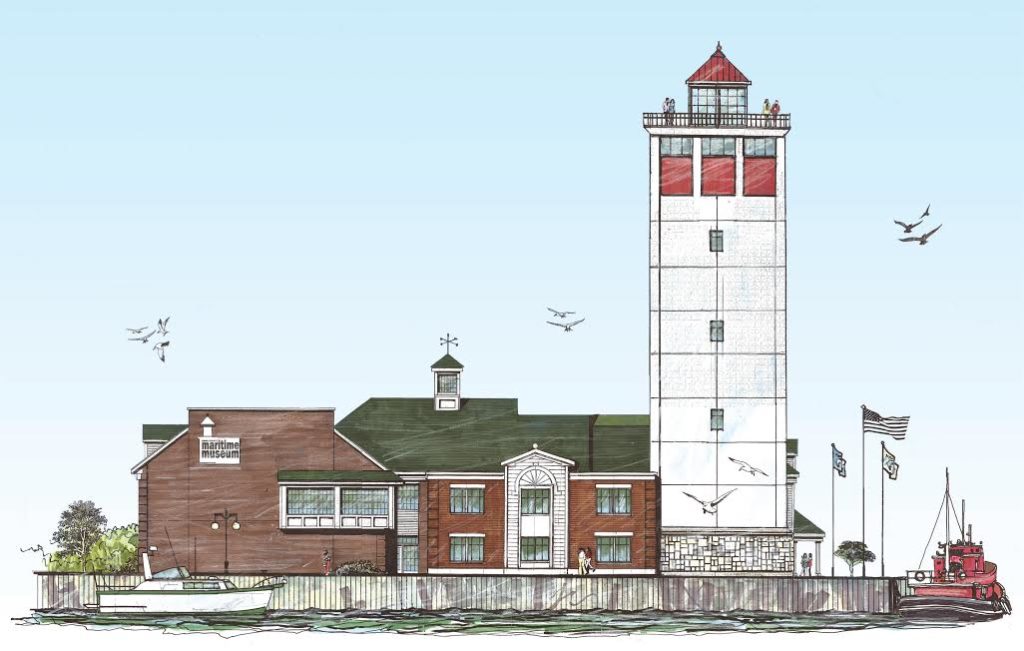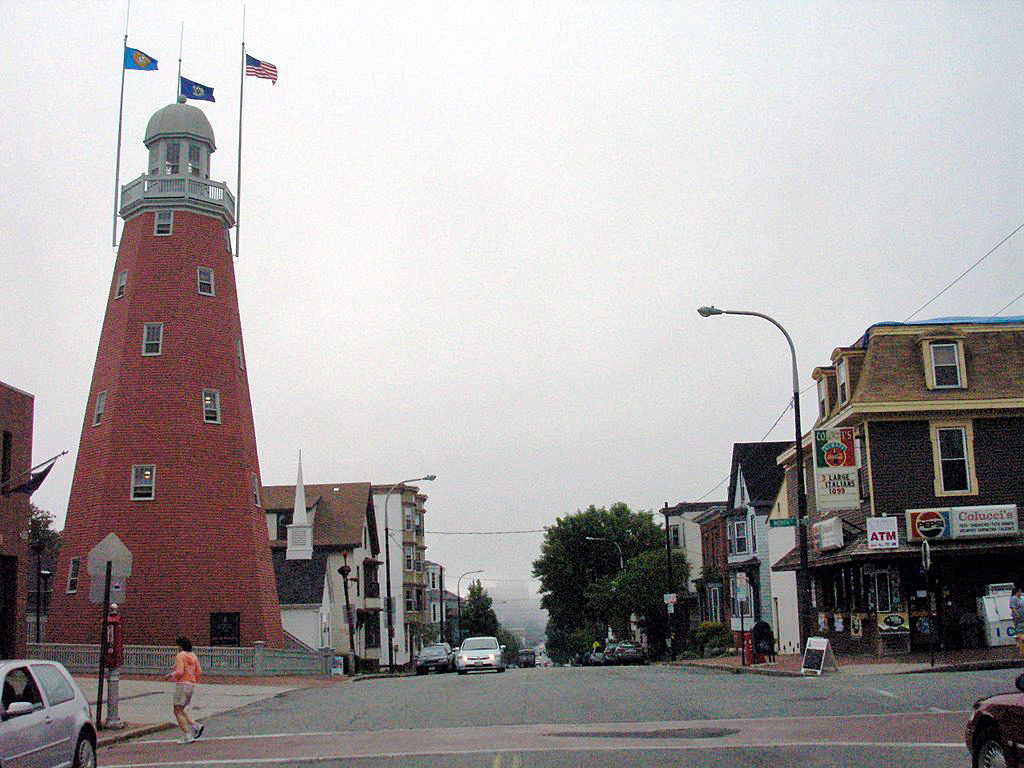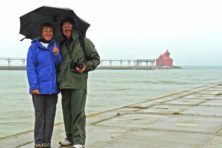Lighthouses – What is the Fascination?
- Share
- Tweet
- Pin
- Share

By Bob Desh
A variety of towers have played essential rolls in the nation’s maritime history. Signal towers, watch towers and light towers in a wide variety of shapes and sizes once dotted America’s coastlines, including here on the Great Lakes. No matter their original purpose, these historic maritime towers continue to fascinate.

A rendering of the proposed maritime tower at Door County Maritime Museum.
The Door County Maritime Museum & Lighthouse Preservation Society is in the process of raising funds to build a 10-story tower addition to its waterfront museum in Sturgeon Bay. Featuring an indoor and an outdoor observation deck along with a displayed Fresnel lens, the structure hopes to emulate aspects of these towers that continue to captivate the public.
Of these important structures, the signal tower, or observatory, is probably the least known and understood. Closely resembling a lighthouse in many ways, these unique signal towers once dominated the skyline of many port cities. The Portland Observatory in Portland, Maine, is the only remaining maritime signal station in the United States.

The observatory in Portland, Maine. Submitted.
In the days before radio communication, the towers were constructed to observe and identify approaching ships at a great distance. Once known, the identity of the vessel could be signaled to local merchants and townspeople ahead of its arrival. The coming of a ship loaded with essential goods, mail, etc. was a huge deal to the entire community in the days of sail. Signaling the vessel’s identity facilitated arrangements for pier space, stevedores to unload cargo, and a variety of other important tasks.
Tower operations were paid with annual fees collected from shipping merchants, who purchased the right to have their flags stored in the building and hoisted up its flagstaffs when their ships were sighted.
Despite being in the midst of a residential neighborhood on a relatively narrow New England street, the Portland Observatory draws thousands of visitors annually to the its perch high above the port. But why? Obviously, the tower’s role as the last of such structures in existence is important to its attractiveness; however, it may be much more complex than that. Those bold enough to scale its winding wooden steps to the telescope lantern 86 feet above the street are rewarded with an incredible, unique view of Portland’s waterfront. The combination of personally experiencing a bit of maritime history combined with the lofty view is irresistible!
Let’s face it, we humans never seem to tire of looking down on our world from a high place. As for the museum’s new tower, a modern elevator will ease the trip to the top of the 10th story enclosed observation deck where visitors will also be able to climb to an open-air, roof-top viewing area.
Like the signal observatory, watch towers at numerous U.S. Life-Saving Service Stations were once a common sight along our coastline. Door County was the home to three such life-saving stations and their noble watch towers. The stations were located in Sturgeon Bay, Baileys Harbor and on Plum Island. Dedicated crewmen would spend hours perched in their watch towers peering out at the oft angry waters of Lake Michigan searching for any sign of a vessel in distress. Countless lives were saved because of these towers and the humans who stood long, lonely watches in hope of rendering timely, critical aid to their fellow mariners.
The most numerous and best known of the historic maritime towers is the light tower. More commonly known as a “lighthouse.” Some have called these unique structures “America’s Castles.” They can be found at the entrance of any major harbor, perched precariously atop a remote shoal or island, or looming over the craggy outcroppings of the nation’s coastline. The practical root of their existence is that of navigational aid. However, they are culturally much more than that.
While the idea behind the lighthouse was a practical one there’s just something elusive about them which fascinates many people. Perhaps it’s their link with the past; perhaps, that they served a heroic purpose. That fascination is very palpable here in Door County where its 11 lighthouses constitute one of the highest concentration of lights in the United States.
The light tower’s intention is to simply save lives, to protect all mariners as they approach rocky shores and bring light in the midst of the fog and darkness. It almost seems as though these breathtaking structures are guarding a secret from the rest of society, tales of lives that were saved and souls that were once housed within their walls. The open sea is an eerie thought, but a flashing light in the distance is always a symbol of hope, tranquility and comfort. The stalwart lighthouse keeper, tending the light in all manner of weather and hardship adds to the mystique. The oft remote location, where land meets sea, compounds the magic.
The proposed maritime tower expansion at the Door County Maritime Museum is designed to be a lasting tribute to all these historic towers. Does it look like a maritime observatory? Yes. Does it look like a maritime watch tower? Yes. Does it look like a lighthouse? Yes. It resembles all maritime towers without replicating any particular structure. It is special, unique and extraordinary in its own right.

The watch tower in Baileys Harbor. Submitted.
Like the watch towers of old those who venture to its observation deck can scan the horizon to identify approaching vessels and celebrate their arrival. Like the watch towers of the Life-Saving Service, visitors will use the lofty view to search for all manner of ships and boats in the waters below. Like the lonely lighthouse, the maritime tower will be the landmark that is forever identified with the working waterfront over which it looms. Add maritime history to the mix and you have something phenomenal.
Bob Desh is the former executive director at the Door County Maritime Museum. Prior to joining the Maritime Museum he served in the United States Coast Guard for more than 36 years, seeing duty on a wide variety of ships and shore units, including two isolated offshore Great Lakes lighthouses. He presently serves on the Board of Regents for the Foundation for Coast Guard History and is a member of the Exhibit Advisory Panel for the National Coast Guard Museum.



